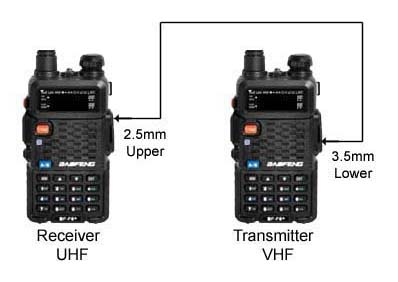
Cross Band Mini-Repeater Project
Fox Hunt made Easy
UV5R, UV82, BFF8, F8HP, UVB5/6 series
|
| Important: This project
demonstrates the capability of the radios as a
one-way cross-band directional ham repeater. Proper licensing and identification is required when using and testing
in this configuration. |
This project shows how to configure two Baofeng
radios as:
- Remote Base
- Fox Hunt Transmitter
- Mobile Cross-Band One-Way Repeater |
Requirements
The requirements are Simple. All that is necessary
for the initial construction is a pair of Baofeng/Pofung
series transceivers and a 2.5mm/3.5mm audio cable.
Connection
The 2.5mm end is plugged into the top jack on the
side of the transceiver as shown below. This unit
will serve as the receiver. The 3.5mm end is
plugged into the lower jack of the transmitter unit.
|
 |
Configuration
The VOX on the TX unit needs
to be turned ON.
With VOX Level set to 1, the TX will drop approximately
2 seconds after the RX squelch closes.
With VOX Level set to 10, the TX will drop immediately
upon RX squelch closing.
Adjust the volume from the RX radio to a comfortable
level.
Added Considerations
for Field Operation
To conserve power:
- turn OFF the ABR (display illumination)
- turn OFF the Roger Beep
- use good antennas, such as J-Poles
- put the RX antenna up about 15' above the TX
Separation /
Isolation
As shown above, one radio
must be set to a UHF frequency
while the other is VHF for these radios to function with
minimal interference The
frequencies selected should be set as far apart as possible.
Choose your frequencies carefully and avoid frequency
multiples. A signal on 147.0 will be heard loudly on its
3rd harmonic of 441.0 MHz
This applies to the antennas as well. The greater the
separation between antennas, the less interference
between radios.
Duplexers
(Two radios using a single antenna)
To operate cross band (VHF/UHF) using a single antenna, a
small dual band duplexer such as a Opek DU-500 or MFJ 916B
would be required. This allows both radios to use a
common antenna without the VHF TX/RX interfering with
the UHF TX/RX. This eliminates the separation
requirements of two antennas.
To operate both radios on the same band, a single band duplexer must be
added. These are much more expense and may be way too
impractical for such a simple project.
Most duplexers are designed for indoor or mobile use.
Outdoors, they should only be used under good weather conditions
avoiding use when there is precipitation.
Side Notes:
-
A "Kitchen Table" test may show the radios appearing to
work when both are set in the same band, but in reality, the transmitter will saturate or
overload the receiver. This is where field testing comes
into play.
-
Another consideration is Power. Handheld radios have
limited heat dissipation and will tend to overheat if
used for long continuous transmissions. For long
duration use, consider running low power and keep
transmissions short to avoid damage to the transmitter.
-
To legally run as a free standing repeater, the addition of an
identifier may be required, depending on your countries
regulations. Some countries only require the control
operator or licensed operators to properly identify.
Accessories
An accessory that you may want to consider for long
duration use is a 12VDC Battery Eliminator. This will
power the radios from either a power supply or battery
source. |
|
|
This is meant to be a fun table top and learning
project with a practical use and a minimal cost investment.
Auxiliary Station FAQ information can be found
here.
|
|
|
|
|